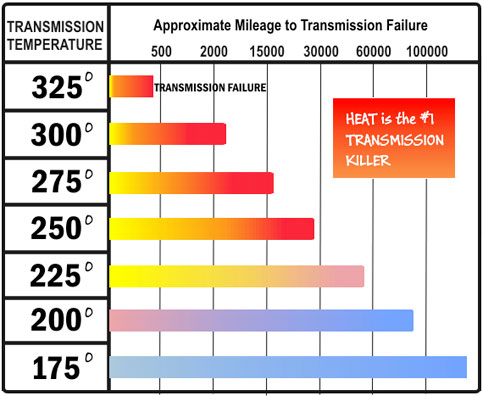You’ve probably experienced a time in your life where you’ve been upset about something and someone told you to “keep your cool”. Our lives and our cars run much better when we can keep our tempers and temperatures in check. We all know that our engines need a good radiator to dissipate the extreme heat produced, but are you aware of how important a good transmission cooler is to the life of your automatic?

The automatic transmission’s number one enemy is heat. Most of us that have wrenched on cars are familiar with the in-the-tank style of radiator coolers found in most passenger vehicles. These types of coolers have been around as long as the automatic transmission and for the most part do an effective job of keeping the transmission going for many thousands of miles. The in-the-tank coolers not only perform the job of cooling the fluid, but warm the fluid in extremely cold environments as well.

Even though historically these simple cooling systems have worked well in the past we need to consider that most of our hot rods are no longer running stock power engines. When we increase the torque and horsepower output of our engines we also increase the stress applied to the transmission. This in turn generates an increased amount of heat that the traditional coolers cannot dissipate as the radiator is also trying to keep the engine temps in check. It is at that point we need to consider adding an external cooler to the system.
The external cooler not only gives you a much greater surface area to extract heat from, but also doesn’t alter the cooling abilities of the radiator. The preferred method of adding an external cooler to the system is to do it as a stand-alone feature, but you can also add it as an addition to the in-the-tank cooler that you may already have. The need for warming the transmission fluid by running it through the radiator is not really a concern for most hot rods since they are typically only driven in fair weather conditions.

Transmission Fluid Color Comparison
When trying to determine the size and type of cooler you need there are a few factors to consider. Most importantly is where it will be mounted and also how big of a cooler will be required to keep the temperatures within range. Most mildly built street driven cars can get by with a relatively small cooler that doesn’t require much space. When mounted in an area that sees direct air flow, such as behind the grille, a stacked plate cooler will be extremely effective in keeping everything running smoothly.
As horsepower and torque increase so will the size of the cooler to an extent, but also consider driving style as part of the equation. Heavier vehicles and vehicles that tow often will need a larger cooler than average to accommodate the extra stress placed on the driveline. Racing applications will also need as large of a cooler as possible to endure the rigors of extended high RPM driving. When it comes to your hot rod you really can’t have too much of a transmission cooler, but you can certainly not have enough.

You will find there are various different types of cooler designs available and each has their own level of effectiveness. We have found through extensive testing that the stacked plate style coolers offer the highest level of efficiency. With the different levels of transmission builds we do in-house, we offer 3 main sizes to cover each type of application and power level. You don’t need to be making huge power to benefit from using an external cooler. We also recommend using a some type of temperature indicator, such as a gauge or one of our transmission guardians, to be sure that if a problem should develop that you have plenty of notice before major damage can occur.


